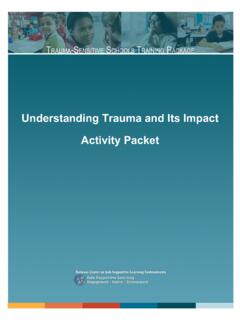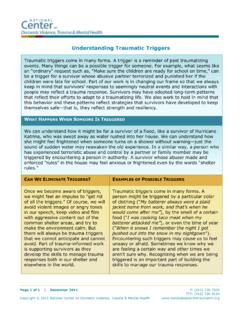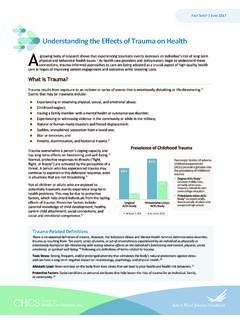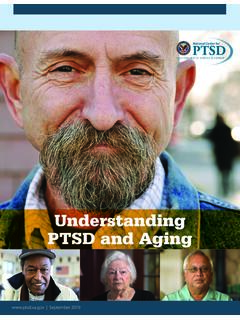Transcription of Understanding vicarious trauma - Centacare
1 The Australian Alliance for Social Enterprise Understanding vicarious trauma Exploring cumulative stress, fatigue and trauma in a frontline community services setting Jonathon Louth, Tanya Mackay, George Karpetis & Ian Goodwin-Smith June 2019 A research report prepared by the The Australian Alliance for Social Enterprise for Centacare Catholic Family Services It s a side effect of empathy I think; we re all going to get it at some level. It s a spectrum I think, vicarious trauma , we re all going to get affected by other people s stuff just based on being empathetic human beings. Focus group participant 1 2 Contents Introduction.
2 6 Organisational Setting .. 8 Internal policy framework .. 9 Literature Review .. 11 vicarious trauma .. 11 Compassion Fatigue .. 12 Burnout .. 13 A Combined Approach .. 13 Mutually exclusive concepts? .. 13 Bringing it all together .. 14 Predictive and Preventative Factors .. 15 Individualised responsibility .. 15 Supervision .. 17 vicarious Resilience .. 17 Method Section .. 19 Methods .. 19 Focus Groups .. 19 ProQOL survey .. 20 Sampling & 20 Ethical Considerations .. 21 Findings and Discussion .. 22 Establishing an organisational baseline .. 22 Demographic Breakdown .. 22 ProQOL findings .. 24 Focus group findings .. 25 The Staff Voice.
3 28 Theme 1: vicarious trauma .. 28 Theme 2: Workload .. 30 Theme 3: Support .. 32 Theme 4: Job Satisfaction .. 34 Concluding Remarks and Recommendations .. 40 Appendices .. 43 Appendix 1 Focus Group Protocol .. 43 Appendix 2 ProQOL survey .. 45 References .. 47 3 Acknowledgements The authors would like to acknowledge and thank Centacare Catholic Family Services staff who contributed to this study. We especially extend our gratitude to project team members Ms Megan Welsh, Dr Jacqueline Amos, Ms Lesley Donnelly, Ms Gayle Tourish. Ms Tracy Ingram and Ms Leeanne Kays. We also would like to thank Ms Elizabeth Rowe and Ms Pauline Connolly for their contributions.
4 We also extend thanks to Centacare Catholic Family Services for partnering with us to produce this work. Acknowledgement of Country The Australian Alliance for Social Enterprise acknowledges the Australian Aboriginal and Torres Strait Islander peoples of this nation. We acknowledge the traditional custodians of the land on which we conducted this research. We pay our respects to ancestors and Elders, past and present. The Australian Alliance for Social Enterprise is committed to honouring Australian Aboriginal and Torres Strait Islander peoples unique cultural and spiritual relationships to the land, waters and seas and their rich contribution to society.
5 For further information Dr Jonathon Louth Research Fellow, The Australian Alliance for Social Enterprise T: +61 8 8302 7095 E: The Australian Alliance for Social Enterprise University of South Australia Business School TASSE Report 1-07/2019 ISBN 978-0-9944347-6-0 Pictures on front cover Photo by C. Cassler from Suggested citation Louth, J., Mackay, T., Karpetis, G. & Goodwin-Smith, I. (2019). Understanding vicarious trauma : Exploring cumulative stress, fatigue and trauma in a frontline community services setting. The Australian Alliance for Social Enterprise, University of South Australia. Adelaide 4 Executive Summary This report identifies risk factors associated with vicarious traumatisation, compassion fatigue and burnout within a community services organisation that provides a diverse suite of programs within vulnerable communities and for families and individual clients across South Australia.
6 Through capturing the staff voice, the report also identifies points of resilience and strength-based responses that stem from undertaking trauma related work. While noting the supportive workplace environment provided by Centacare Catholic Family Services, key protective and predictive factors identified within the report include: The positive and negative links between work satisfaction and compassion fatigue; The importance of and risks associated with informal support networks; The need for space, time and boundaries; The significance of elevating client voice and sharing small wins ; The importance of freedom to express and discuss trauma -based work; and, The need for funding arrangements that incorporate protective and predictive factors for workforces.
7 Action on vicarious trauma is of paramount importance to community service organisations and the organisations that fund them. From workforce retention, through to the health and wellbeing of workers and the translation of workforce wellbeing into optimal client outcomes and social and economic impact, there are compelling reasons to embed vicarious trauma mitigation strategies within organisations and service contracts. 5 6 Introduction We walk alongside the clients. We listen to those stories. We invest emotionally. We are human, so it has to have an impact. trauma cannot be wished away.
8 It needs to be managed, worked through and monitored by workers and clients alike. Moreover, trauma does not simply disappear when workers go home: It leaves a residual presence that can contribute to a cumulative reaction. Empathetic stress, burnout, compassion fatigue, secondary traumatic stress and vicarious trauma speak to a spectrum of dissociative or disjunctive effects (Killian, et al., 2017; Hernandez-Wolfe, et al. 2007). vicarious trauma is an unavoidable consequence of working with trauma survivors. For workers in the caring professions, this can mean actual harm over time. Indeed, there are workers who feel that their experiences are less vicarious and represent direct trauma (Pack, 2013).
9 With the rapid expansion of the community services sector over the past few decades, this represents a ticking timebomb . Frontline workers are experiencing high levels of trauma that will impact their everyday lives well into the future. They represent a generation of veterans who are not returning from war, but from working within vulnerable communities and families within our cities, suburbs and regions. This situation cannot and should not be ignored. However, exposure to trauma can also be transformational and radically impact a person s self-perception and life narrative. Often and understandably the viewpoint for practitioners has focused on mitigating the negative effects of traumatic experiences.
10 Dealing with trauma is what they do everyday. But we can also look to post-traumatic growth and vicarious resilience. Why is it that some clients and workers deal better with traumatic situations than others? Is it possible to identify strength-based approaches to dealing with vicarious trauma ? Through the deployment of an organisational-wide validated survey and a series of in-depth focus groups, this study provides a comprehensive analysis of vicarious trauma within a large community services sector organisation. Our study identifies a number of key protective factors for workers in traumatic environments: Work satisfaction: There is a very strong correlation between compassion fatigue and work satisfaction.







